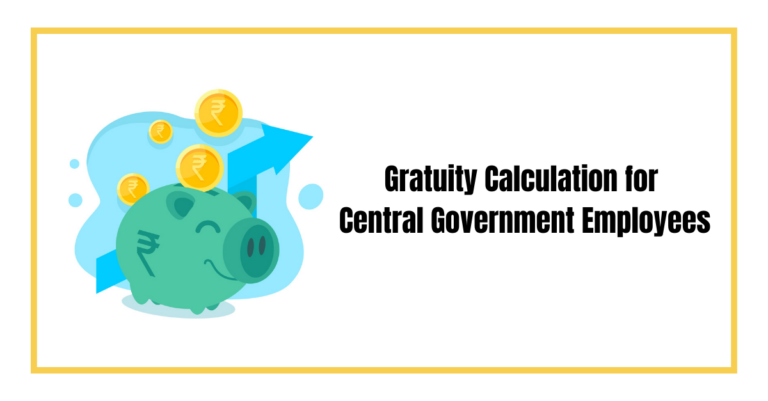Gratuities are a form of compensation for services rendered by the employees. The amount of gratuity depends on the type of service provided. In India, there is a specific gratuity rule that every employer needs to follow. In this blog, we will talk about the Gratuity Act of 1972 and how it is calculated.
What is Gratuity?
The above are the definitions of gratuity in layman’s terminologies. Now let us have a discussion at length and in detail. Gratuity is the total amount of money a worker or an employee of an organisation receives while moving on to another organisation. This gratuity is a consideration of appreciation received for the services delivered. A worker or an employee is required to adhere to certain conditions to get entitled to gratuity. Let’s know about details of the Payment of Gratuity Act 1972.
The Payment of Gratuity Act 1972
Rules under Payment of Gratuity Act 1972
An employer sanctions an employee for the gratuity payment if the employee has provided 5 years of uninterrupted service to the organisation. But, 5 years is not a strict condition for death or other disabilities. For example, a retired employee is also sanctioned for gratuity money and his pension.
The exception is when an employee passes away or gets disabled due to an accident or significant disease. Then, the organisation is bound to pay the gratuity amount to the employee’s nominee irrespective of the number of years of service provided.
The Gratuity calculation act 1972 also has a stipulation for minors. The supreme authority has to transfer the gratuity money to the respective bank account for the benefit of the minor until they become a major and can possess the history and the amount. Furthermore, the Act also provides for the services of even 6 months, and the gratuity amount will be based on the rate of 15 days of wages divided by the speed of salary drawn on the last date concerned. One should not consider overtime payment under the gratuity amount paid by the organisation. The gratuity for employee cannot exceed 10 lakhs.
According to the Act, an employee has the right to receive a gratuity amount. However, the right to receive gratuity can be shortened on two conditions:
- The organisation terminates an employee based on obstinate omission or loss, damage, or destruction of the organisation’s property or belongings;
- If the organisation terminates an employee for misconduct or immoral offences in the organisation.
The gratuity rules also recommend that once an employee or worker becomes eligible for receiving the gratuity amount from the organisation, the employee has to apply within a month from the applicable date. Furthermore, if the retirement date or death date is known, the application should be made beforehand, say a month. An organisation cannot rebuff an application provided by an employee after a month, and if a delay has occurred, valid reasons must be provided for it. The gratuity payment clarifies that an application cannot be rebuffed based on invalid reasons like the application after the expiry date. The organisation has to mention the amount paid to the employee and the date of payment within 15 days of receiving the application for gratuity payment. Once that is completed, the payment has to be done a month from the date of receiving the application. If the application is rejected, the organisation has to provide a valid reason to the employee.
Suppose the nominee of an employee claims the gratuity amount. In that case, the organisation or employer may ask for a solid witness or proof of evidence as deemed applicable for supporting the employee’s heir. This assures the originality of the terms and conditions. When an employer faces such a case, the organisation has to accept the claim or evidence for payment of gratuity amount from the date to be furnished to the organisation. The mode of gratuity payment can be via cheque, cash or by DD (Demand Draft).
An employee or a nominee can file a complaint to the higher authority in case of the following conditions:
- If the organisation rebuffs to accept the application by the employee for the gratuity money;
- If the gratuity amount paid is less than the actual amount; and
- Even after receiving the payment, the specified amount for gratuity is missing or fails to make the payment within the time.
Any complaint made by the employer or the employee must be filed to the Assistant Labor Commissioner within 90 days from the event occurred. A commissioner can accept the criticism even after 90 days if the reasons provided are valid and too crucial to neglect. If a complaint file has been put forward, the person has to be present at the time and place mentioned by the commissioner. The absence of the person for the hearing may lead to the dismissal of the application. But if the reasons are genuine for the absence, a review can be made within a month for re-hearing the case. However, if the employer fails to be present on the date and time of re-hearing, the commissioner will precede the hearing for the employee’s benefit.
Gratuity Payment Calculation Formula
The gratuity act rules of the gratuity act have specific formulae for calculating the gratuity equity. This comprises 15 days’ worth of remuneration for a complete year with the same organisation and is based on the last remuneration received. The last digit in the last basic salary is withdrawn and added to the allowance which does not include HRA. Let us consider the gratuity calculation formula as per gratuity act 1972 for the calculation of gratuity as follows:
According to the Central Government, the largest gratuity amount payable is 20 lakhs for a retired employee or after death/disablement. Retirement gratuity equals 1/4th of the emoluments for each whole 6months period of service provided according to the Pension Rules of 2021. The gratuity amount is the largest of sixteen and a half times the emoluments.
Death Gratuity is paid to the family of the late employee for their time in service. The rate of payment for death and suicide gratuity are as follows:
- If the service is subordinate to 1 year, gratuity is 2 times the payments;
- If the service is 1 year or more but subordinate to 5 years, gratuity is 6 times that of payments;
- If the service is 5 years or more but subordinate to 11 years, gratuity is 12 times the payments;
- If the service is 11 years or more but subordinate to 20 years, gratuity is 20 times that of payments; and,
- If the service is 20 years or more, gratuity is 33 times that of payments.
Different Types of Gratuity Forms
The payment of gratuity act 1972 is a welfare statute supplied for the welfare of the employees who are considered the backbone of an organisation. However, there are different types of forms of gratuity and they are as follows:
- Form I: to use the application for the payment of gratuity;
- Form J: to make an application for the payment of gratuity by the nominee;
- Form K: to make an application for the payment of gratuity by the legal heir;
- Form F: to make a nomination;
- Form G: to make a fresh nomination;
- Form H: to change a nomination made;
- Form L: to state the amount and date of payment;
- Form M: the reason for rejection;
- Form N: application made to a higher authority;
- Form O: to appear for a case hearing by the authority;
- Form P: summon issued by the authority for a hearing;
- Form R: authority directing to make gratuity payment.
Conclusion
The gratuity payment encourages the employee to provide efficient work and increase and expand the products according to the Payment of Gratuity Act of 2018. The Central Government has tried to promote social welfare by leveraging female employees for maternity leave. Yet, the scope of this gratuity payment act restricts large scale organisations and is also not applicable to an organisation with less than 10 employees. The significant change to be made is in the modification of the implementation of the Act: https://clc.gov.in/clc/acts-rules/payment-gratuity-act as it is still not being adequately followed or regulated for both employees and organisations.
FAQ
What is the Gratuity Act of 1972, and how does it impact employees?
The Gratuity Act of 1972 is a law that mandates employers to pay gratuities to their employees who have completed five or more years of continuous service. The Act impacts employees by providing them with a financial benefit upon retirement, resignation or death.
What are the basic eligibility criteria for receiving gratuity payment?
To receive gratuity payment, an employee must have completed five or more years of continuous service with the same employer. The employee must also be eligible for superannuation, retirement or resignation.
How has the gratuity calculation changed under the new rules in 2023?
There have been no changes to the gratuity calculation under the new rules in 2023.
Is it true that you need to have a minimum of 4 years and 6 months of service to be eligible for gratuity?
No, it is not true. To be eligible for gratuity, an employee must have completed five or more years of continuous service with the same employer.
Can you clarify whether gratuity is payable for employees with less than 5 years of service?
No, gratuity is not payable for employees with less than five years of continuous service with the same employer.
What is the specific time limit within which employers must make gratuity payments to their employees?
Employers must make gratuity payments to their employees within 30 days from the date from which the gratuity becomes payable.
Is it possible to receive gratuity after completing 4 years and 5 months of service?
No, it is not possible to receive gratuity after completing 4 years and 5 months of service. An employee must have completed five or more years of continuous service with the same employer to be eligible for gratuity.
Are employees with 4 years and 8 months of service eligible for gratuity under the Gratuity Act 1972?
No, employees with 4 years and 8 months of service are not eligible for gratuity under the Gratuity Act 1972. An employee must have completed five or more years of continuous service with the same employer to be eligible for gratuity.
Is there a provision for gratuity payment after 4 years and 9 months of service?
No, there is no provision for gratuity payment after 4 years and 9 months of service. An employee must have completed five or more years of continuous service with the same employer to be eligible for gratuity.
Can you explain the conditions under which someone with 4 years and 240 days of service is eligible for gratuity?
Someone with 4 years and 240 days of service is not eligible for gratuity. An employee must have completed five or more years of continuous service with the same employer to be eligible for gratuity.
Read more,










